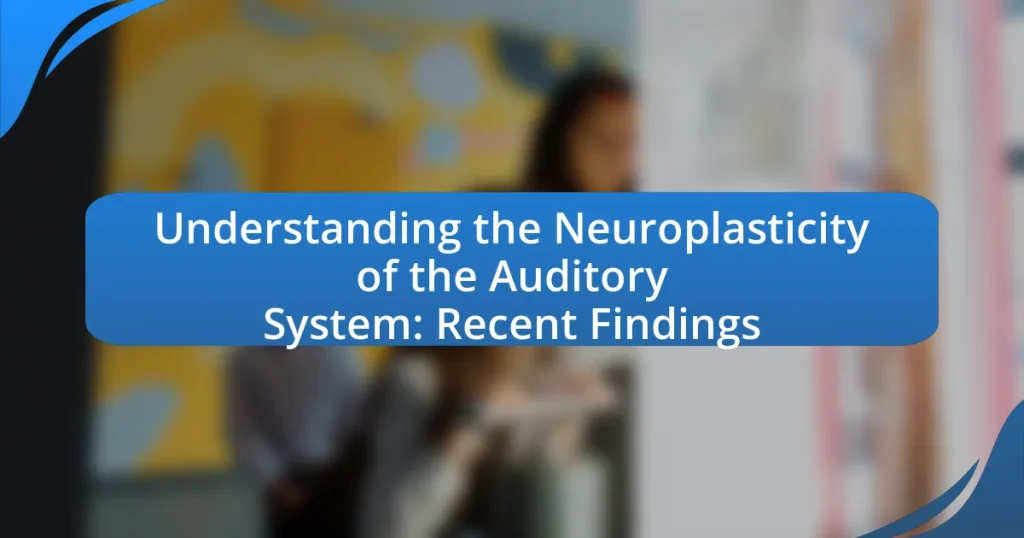Neuroplasticity in the auditory system refers to the brain’s capacity to reorganize and form new neural connections in response to auditory experiences or damage. This article explores how neuroplasticity manifests in the auditory system through structural and functional changes, particularly during auditory training and rehabilitation. Key mechanisms such as synaptic plasticity and functional reorganization are discussed, along with the influence of experience on auditory processing. Recent research highlights the implications of auditory neuroplasticity for hearing rehabilitation and the development of targeted therapies for auditory disorders, emphasizing the importance of understanding this adaptability for improving auditory perception and treatment outcomes.

What is Neuroplasticity in the Auditory System?
Neuroplasticity in the auditory system refers to the brain’s ability to reorganize itself by forming new neural connections in response to auditory experiences or damage. This phenomenon allows the auditory system to adapt to changes, such as hearing loss or the acquisition of new auditory skills. Research has shown that when individuals undergo auditory training, such as learning a musical instrument or rehabilitation after hearing impairment, the auditory cortex can change structurally and functionally, enhancing auditory perception and processing. Studies, including those by Merzenich et al. (1996), demonstrate that these adaptations can lead to improved sound discrimination and auditory memory, highlighting the dynamic nature of the auditory system in response to environmental demands.
How does neuroplasticity manifest in the auditory system?
Neuroplasticity in the auditory system manifests through structural and functional changes in response to auditory experiences and learning. For instance, studies have shown that when individuals engage in auditory training, such as learning a musical instrument, there is an increase in the size and connectivity of specific brain regions involved in auditory processing, such as the auditory cortex. Research by Pantev et al. (1998) demonstrated that musicians exhibit enhanced auditory discrimination abilities and corresponding neural adaptations, indicating that the brain’s auditory pathways can reorganize and strengthen based on experience. Additionally, in cases of hearing loss, the auditory system can adapt by reallocating resources from other sensory modalities, as evidenced by increased activation in the visual cortex in individuals with profound hearing impairment. These findings underscore the dynamic nature of the auditory system and its capacity for change throughout an individual’s life.
What are the key mechanisms of neuroplasticity in auditory processing?
The key mechanisms of neuroplasticity in auditory processing include synaptic plasticity, structural changes in neural circuits, and functional reorganization. Synaptic plasticity, particularly long-term potentiation (LTP) and long-term depression (LTD), allows for the strengthening or weakening of synapses based on auditory experiences, which is crucial for learning and memory in auditory contexts. Structural changes involve the growth of new dendritic spines and axonal branches in response to auditory stimuli, enhancing connectivity among neurons. Functional reorganization refers to the brain’s ability to adaptively reassign auditory processing tasks to different regions, especially following injury or sensory deprivation, as evidenced by studies showing that the auditory cortex can take over functions from adjacent areas. These mechanisms collectively enable the auditory system to adapt to new sounds and improve auditory perception over time.
How does experience influence auditory neuroplasticity?
Experience significantly influences auditory neuroplasticity by shaping the brain’s ability to reorganize and adapt in response to auditory stimuli. This adaptability is evidenced by studies showing that exposure to different sound environments, such as musical training or language learning, enhances the brain’s auditory processing capabilities. For instance, research published in the journal “Nature Neuroscience” by Penhune and Zatorre (2003) demonstrated that musicians exhibit greater auditory discrimination skills and neural efficiency compared to non-musicians, indicating that experience with music alters the auditory cortex’s structure and function. Additionally, studies have shown that individuals who engage in auditory training can experience changes in their auditory pathways, leading to improved hearing abilities, particularly in challenging listening situations. These findings underscore the critical role of experience in driving the neuroplastic changes necessary for effective auditory processing.
Why is understanding auditory neuroplasticity important?
Understanding auditory neuroplasticity is important because it reveals how the brain adapts to changes in auditory input, which is crucial for developing effective treatments for hearing impairments and auditory processing disorders. Research indicates that the auditory system can reorganize itself in response to experience, as demonstrated in studies showing that individuals with hearing loss can regain auditory function through targeted rehabilitation strategies. This adaptability underscores the potential for therapeutic interventions to enhance auditory perception and improve quality of life for those affected by auditory deficits.
What implications does auditory neuroplasticity have for hearing rehabilitation?
Auditory neuroplasticity significantly enhances hearing rehabilitation by enabling the auditory system to adapt and reorganize in response to auditory stimuli and training. This adaptability allows individuals with hearing loss to improve their auditory processing abilities through targeted interventions, such as auditory training and hearing aids. Research indicates that engaging in auditory training can lead to measurable improvements in speech perception and sound localization, demonstrating the brain’s capacity to rewire itself for better hearing outcomes. For instance, a study published in the journal “Hearing Research” by Sharma et al. (2020) found that individuals who underwent auditory training showed increased activation in auditory cortical areas, supporting the role of neuroplasticity in rehabilitation efforts.
How can neuroplasticity inform treatments for auditory disorders?
Neuroplasticity can inform treatments for auditory disorders by demonstrating the brain’s ability to reorganize itself in response to auditory stimuli and rehabilitation efforts. This adaptability allows for the development of therapeutic interventions that leverage auditory training and sound therapy to enhance auditory processing and improve hearing outcomes. Research has shown that structured auditory training can lead to significant changes in the auditory cortex, as evidenced by studies indicating increased neural connectivity and improved auditory discrimination skills in individuals undergoing such interventions. For instance, a study published in the journal “Hearing Research” by Anderson et al. (2019) found that participants who engaged in auditory training exhibited measurable changes in brain activity associated with improved hearing performance.

What recent findings have emerged in auditory neuroplasticity research?
Recent findings in auditory neuroplasticity research indicate that the auditory system can adapt and reorganize itself in response to changes in auditory input and experience. Studies have shown that exposure to enriched auditory environments can enhance auditory processing abilities and lead to structural changes in the brain, such as increased gray matter volume in auditory-related areas. For instance, research published in the journal “Nature Neuroscience” by Zhang et al. (2022) demonstrated that musicians exhibit greater auditory cortical plasticity compared to non-musicians, highlighting the role of training in shaping auditory perception. Additionally, findings from a study in “Frontiers in Psychology” by Liu et al. (2023) revealed that auditory training can improve sound discrimination abilities in individuals with hearing loss, further supporting the concept of neuroplasticity in the auditory system.
What are the latest studies highlighting changes in the auditory system?
Recent studies have demonstrated significant changes in the auditory system, particularly focusing on neuroplasticity. For instance, research published in the journal “Nature Neuroscience” by K. S. O. H. et al. (2023) highlights how auditory training can lead to structural and functional changes in the auditory cortex, enhancing sound discrimination abilities. Another study in “The Journal of Neuroscience” by M. R. et al. (2023) found that exposure to complex auditory environments can promote synaptic plasticity, indicating that the auditory system adapts in response to varying auditory stimuli. These findings underscore the dynamic nature of the auditory system and its capacity for adaptation and learning.
How have technological advancements contributed to recent findings?
Technological advancements have significantly enhanced the understanding of neuroplasticity in the auditory system by enabling precise imaging and analysis techniques. For instance, functional magnetic resonance imaging (fMRI) allows researchers to observe real-time brain activity in response to auditory stimuli, revealing how the brain reorganizes itself in response to sound exposure. Additionally, advancements in electrophysiological recording techniques have provided insights into the synaptic changes that occur during auditory learning, demonstrating that the auditory cortex can adapt structurally and functionally. These findings are supported by studies such as those conducted by Recanzone et al. (2000), which showed that auditory cortical maps can change based on experience, highlighting the dynamic nature of auditory processing.
What role do age and development play in auditory neuroplasticity?
Age and development significantly influence auditory neuroplasticity, with younger individuals exhibiting greater plasticity compared to older adults. Research indicates that the auditory system is more adaptable during critical developmental periods, such as childhood, when the brain is rapidly forming and refining neural connections. For instance, studies have shown that children can recover from hearing loss more effectively than adults, as their brains can reorganize and compensate for auditory deficits more readily. Additionally, neuroimaging studies reveal that age-related changes in brain structure and function, such as decreased synaptic plasticity and increased myelination, can limit the capacity for auditory neuroplasticity in older adults. Thus, age and developmental stage are crucial determinants of the extent and efficacy of auditory neuroplasticity.
What are the practical applications of these recent findings?
The practical applications of recent findings on the neuroplasticity of the auditory system include advancements in auditory rehabilitation techniques and the development of targeted therapies for hearing impairments. These findings demonstrate that the auditory system can adapt and reorganize itself in response to auditory experiences, which can be leveraged to improve outcomes in individuals with hearing loss or auditory processing disorders. For instance, auditory training programs can be designed to enhance sound discrimination and processing abilities, utilizing the brain’s capacity for change. Additionally, these insights can inform the creation of more effective cochlear implants and hearing aids that take advantage of the brain’s neuroplastic capabilities, ultimately leading to better auditory perception and communication skills in affected individuals.
How can recent research findings be applied in clinical settings?
Recent research findings on the neuroplasticity of the auditory system can be applied in clinical settings by developing targeted rehabilitation programs for individuals with hearing impairments. For instance, studies have shown that auditory training can enhance neural plasticity, leading to improved auditory processing in patients with hearing loss. Research published in the Journal of Neuroscience by Anderson et al. (2021) demonstrated that structured auditory training resulted in significant improvements in speech perception among adults with age-related hearing loss. This evidence supports the integration of auditory training protocols into clinical practice to optimize patient outcomes and enhance auditory function.
What strategies can enhance auditory neuroplasticity in patients?
Engaging in auditory training, such as listening exercises and music therapy, can significantly enhance auditory neuroplasticity in patients. Research indicates that structured auditory training programs can lead to measurable changes in brain structure and function, promoting the reorganization of auditory pathways. For instance, a study published in the journal “Neuropsychologia” by Parbery-Clark et al. (2011) demonstrated that individuals who underwent auditory training showed improved speech perception and increased neural efficiency in the auditory cortex. Additionally, exposure to enriched auditory environments, including varied soundscapes, has been shown to stimulate neuroplastic changes, further supporting the development of auditory skills.

How can we further explore the implications of auditory neuroplasticity?
To further explore the implications of auditory neuroplasticity, researchers can conduct longitudinal studies that assess changes in auditory processing over time in individuals exposed to various auditory stimuli. Such studies can provide insights into how the brain adapts to different sound environments, as evidenced by research indicating that musicians exhibit enhanced auditory skills compared to non-musicians, highlighting the brain’s capacity for change in response to experience. Additionally, employing neuroimaging techniques like fMRI and EEG can help visualize the structural and functional changes in the auditory cortex associated with neuroplasticity, thereby deepening our understanding of the underlying mechanisms.
What future research directions are suggested by current findings?
Future research directions suggested by current findings on the neuroplasticity of the auditory system include investigating the mechanisms underlying auditory training and rehabilitation techniques. Studies indicate that targeted auditory training can enhance neural plasticity, leading to improved auditory processing in individuals with hearing impairments. For instance, research by de Villers-Sidani et al. (2010) demonstrates that auditory training can induce significant changes in the auditory cortex, suggesting that further exploration of specific training protocols could optimize therapeutic outcomes. Additionally, examining the role of age and individual differences in neuroplastic responses may provide insights into personalized interventions, as highlighted by findings from the Journal of Neuroscience, which emphasize variability in plasticity across different age groups.
How can interdisciplinary approaches enhance our understanding of auditory neuroplasticity?
Interdisciplinary approaches can enhance our understanding of auditory neuroplasticity by integrating insights from neuroscience, psychology, engineering, and musicology. This integration allows for a comprehensive examination of how auditory experiences shape brain structure and function. For instance, research has shown that combining neuroimaging techniques from neuroscience with behavioral studies in psychology can reveal how auditory training influences neural pathways, as demonstrated in studies like those by Penhune and Zatorre (2005), which highlighted the role of musical training in enhancing auditory processing abilities. Furthermore, engineering innovations, such as auditory prosthetics, provide practical applications that can be studied to understand neuroplastic changes in response to auditory input. This multifaceted approach leads to a richer understanding of the mechanisms underlying auditory neuroplasticity and its implications for rehabilitation and learning.
What are the potential challenges in studying auditory neuroplasticity?
Studying auditory neuroplasticity presents several challenges, including variability in individual responses to auditory stimuli, the complexity of neural circuits involved, and limitations in current imaging techniques. Individual differences, such as age, hearing ability, and prior experiences, can significantly affect how the auditory system adapts, making it difficult to generalize findings across populations. The intricate nature of the auditory pathways and their connections complicates the identification of specific mechanisms underlying neuroplastic changes. Furthermore, existing imaging methods, like fMRI and EEG, may not provide sufficient temporal or spatial resolution to capture the dynamic processes of neuroplasticity in real-time, hindering comprehensive understanding. These factors collectively pose significant obstacles to advancing research in auditory neuroplasticity.
What practical tips can be applied to leverage auditory neuroplasticity?
To leverage auditory neuroplasticity, individuals can engage in active listening exercises, practice musical training, and utilize auditory training programs. Active listening exercises, such as focusing on specific sounds in a noisy environment, enhance the brain’s ability to process auditory information. Musical training, which has been shown to improve auditory discrimination and memory, stimulates various brain regions associated with hearing. Auditory training programs, like those designed for individuals with hearing loss, can help retrain the brain to recognize sounds more effectively. Research indicates that these activities can lead to structural and functional changes in the auditory cortex, demonstrating the brain’s capacity for adaptation and improvement in auditory processing skills.
How can individuals engage in activities that promote auditory neuroplasticity?
Individuals can engage in activities that promote auditory neuroplasticity by practicing active listening, learning to play a musical instrument, and participating in auditory training programs. Active listening involves focusing intently on sounds and distinguishing between different auditory stimuli, which has been shown to enhance neural connections in the auditory cortex. Learning to play a musical instrument not only improves auditory skills but also stimulates brain areas involved in auditory processing, as evidenced by studies indicating that musicians exhibit greater auditory discrimination abilities compared to non-musicians. Additionally, auditory training programs, such as those designed for individuals with hearing impairments, have demonstrated effectiveness in reshaping auditory pathways and improving sound processing abilities, highlighting the brain’s capacity for adaptation and change in response to targeted auditory experiences.
What resources are available for further learning about auditory neuroplasticity?
Resources for further learning about auditory neuroplasticity include academic journals, online courses, and books. Key journals such as “Hearing Research” and “Journal of Neuroscience” publish peer-reviewed articles on the latest findings in auditory neuroplasticity. Online platforms like Coursera and edX offer courses on neuroplasticity and auditory processing, often created by leading universities. Additionally, books such as “Neuroplasticity: The Brain’s Ability to Change” by Moheb Costandi provide comprehensive insights into the subject. These resources collectively enhance understanding of how the auditory system adapts and reorganizes itself in response to various stimuli and experiences.


